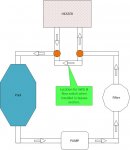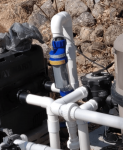I think I know the answer to the question, but I'll ask anyway. Is it an issue to install a SWG ahead of the heater? I'm installing all new equipment (expect for heater) and the optimal place, from a routing perspective would be to install the SWG cell after the filter and before the heater. I will also be installing diverter valves to bypass the heater when not in use and my plan would be to put the flow switch on the bypass so the SWG will have fail safe to only run when pump is running and flow is trough the bypass. My alternative is to put the cell in bypass pipe but this creates a tighter pad and a few more bends in the plumbing. My first thought was this would be bad because of highly chlorinated water going into the heater and potentially the gasses from the cell but the bypass addresses this. Plus, the water from the cell is only a few ( 5 or 7) ppm higher that my target FC anyway.
Am I missing something else? Advice?
Am I missing something else? Advice?



